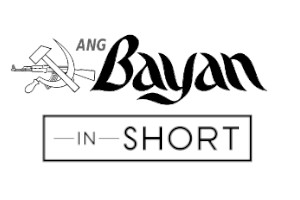The Coco Levy Fund swindle

In the late 1970s, widespread peasant protests broke out over the US-Marcos I dictatorship’s fraudulent Coco Levy Fund. To pacify the peasant masses’ militant rising, Marcos ordered the suspension of the levy collection on September 17, 1980.
It failed to placate the enraged coconut farmers. They could not accept how billions upon billions of peses were taken from them by the dictator in collusion with coconut farm landlords.
On February 1, 1981, a few days before Pope John Paul II’s visit to Manila, 6,000 coconut farmers from five towns of Quezon launched a protest. As they assembled in the plaza of Guinayangan town, soldiers from the Philippine Constabulary opened fire. Two were killed and up to a thousand were injured. The same violence was repeated on July 14 that year when soldiers attacked hundreds of coconut farmers who were protesting in Daet, Camarines Norte. Seven were killed and more than 20 were injured.
Despite the violent response of the fascist state, protests continued nationwide until Marcos Sr finally suspended the coco levy collection on September 11, 1983. Since then, coconut farmers have struggled to recover the billions of pesos stolen from them.
What is the coco levy fund?
The coco levy is a series of taxes imposed under the US-Marcos dictatorship that squeezed coconut farmers dry like grated coconut. The proceeds were supposedly to create a fund aimed at “developing the livelihood” of the country’s coconut farmers and the coconut industry.
The opposite happened. Marcos and his cronies pocketed and looted the levies. Among them were Juan Ponce Enrile (then the Minister of Defense and now Marcos Jr’s legal adviser), Eduardo “Danding” Cojuangco and Maria Clara Lobregat, a big landlord and coconut big business owner from Zamboanga.
Levy collection began on June 17, 1971 at the rate of ₱0.55 per 100 kilograms of copra (equivalent to ₱38.45 in 2020). The fund was then managed by the Philippine Coconut Federation, Inc., the largest organization of coconut businesses.
Under martial law, the dictator repeatedly swindled the coconut farmers. On June 30, 1973, Marcos Sr issued PD 232 which formed the Philippine Coconut Authority (Philcoa) and installed Enrile as president. In August 1973, the Coconut Consumers’ Stabilization Fund (CCSF) was formed and an additional ₱15 per 100 kilograms of copra was levied against coconut farmers. These coconut levies were then invested in private companies. Up to ₱100 million per month went to compradors, exporters and other big coconut businesses. On November 14 of the same year, the Coconut Industry Development Fund was formed to collect another ₱20 per 100 kilograms of copra.
Squeezing farmers
On July 29, 1975, Marcos issued PD 755 to authorize Philcoa to buy 64.98% of the shares of the First United Bank using the coco levy fund. From this was established the United Coconut Planter’s Bank (UCPB) with Cojuangco getting 7.2% shares and Marcos Sr getting 10%. Cojuangco was made bank president. In 1978, United Coconut Oil Mills was formed which controlled 97% of all coconut industry.
According to estimates of the Kilusang Magbubukid ng Pilipinas, coconut farmers lost 42% of their incomes from 1979 to 1982 due to the coco levy and the coconut monopoly. Marcos Sr. pocketed ₱9.8 billion. Overall, ₱150 billion coco levy funds were plundered by his cronies.
Marcos Sr’s cronies controlled 81% of collected coco levy. Cojuangco used these funds to buy the UCPB, the San Miguel Corporation and 14 other coconut companies (he died without returning the companies). Meanwhile, Enrile used the coco levy to buy Primex Coco, Pacific Royal, Clear Minerals and more.



